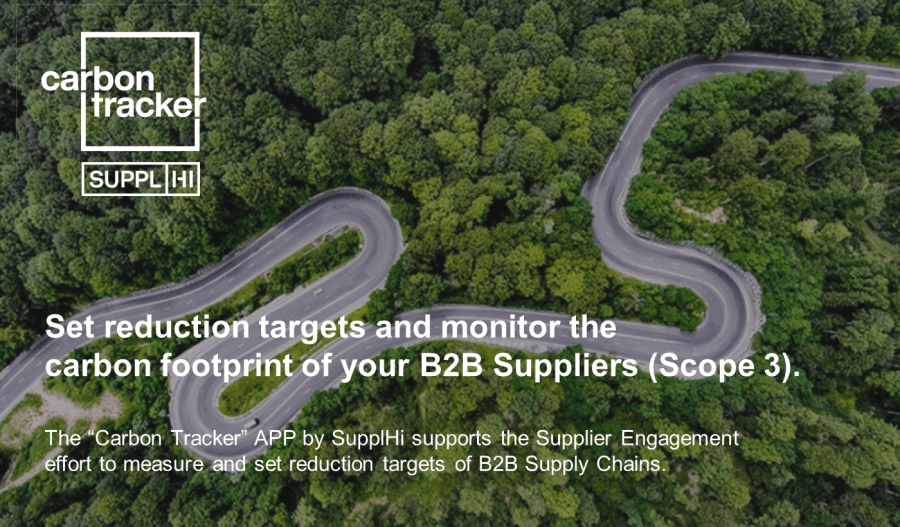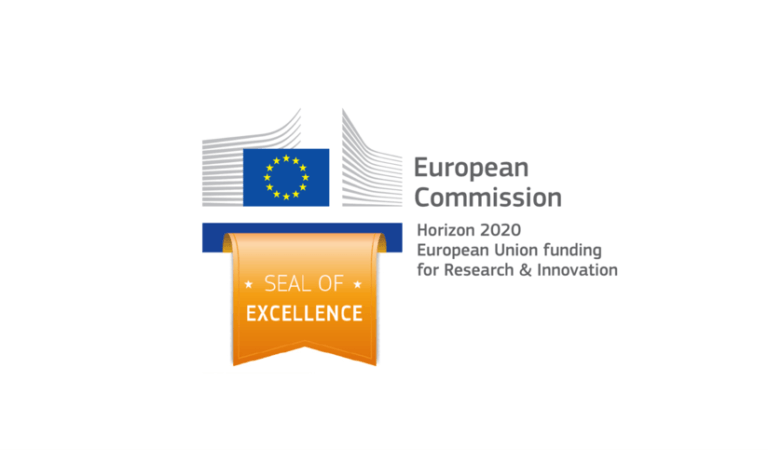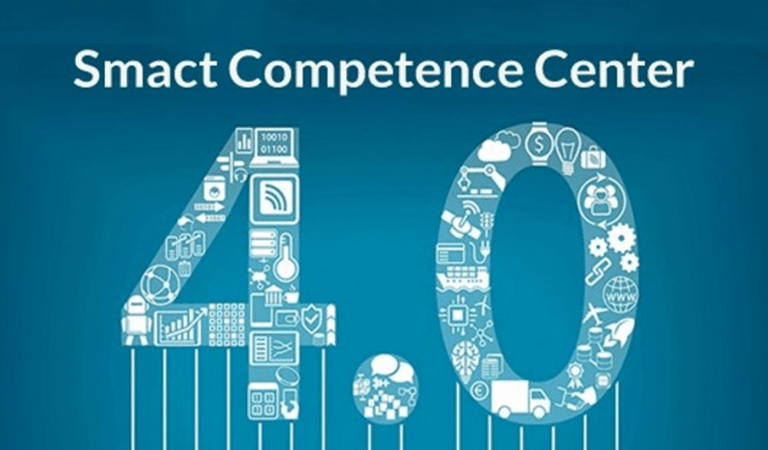Milan, April 18th, 2021
Carbon Emissions and the fight against Climate Change are a global imperative embraced by all main governments and large corporations, and the reduction of greenhouse gas (GHG) emissions is one of the most important. Within the GHG, Scope 3 emissions – also known as value chain emissions – in industrial B2B (Energy, Shipbuilding, Construction, Manufacturing, …) in some cases can account for up to 90% of the total carbon impact.
Carbon measurement and reduction is therefore a Supply Chain-wide effort and Buyers are becoming more and more responsible for the CO2 emissions of their suppliers (e.g. the ruling issued in May 2021 by the Hague District Court versus the Shell Group). In this global scenario, it is now clear that Industrial Buyers need to boldly stimulate and carefully monitor suppliers and sub-suppliers to develop carbon emissions inventories and to set challenging reduction targets.
Due the presence of a fragmented, long, and complex Supply Chains in the industrial B2B, accounting of carbon emissions is particularly difficult. In fact, beyond the largest and listed players (e.g. ABB, Schneider Electric, Tenaris, …) that reached the adoption of Science Based Targets, only 2% of the SMEs that are the typical backbone of industrial supply chains are report their CO2 emissions and have a reduction target in place.
How do I collect trusted Primary data (including realistic reduction targets) on CO2 beyond the top 10% of Suppliers? How do I encourage a fast and solid adoption of CO2 metrics in a fragmented supply chain made of SMEs and several layers? How do I monitor and collaborate on CO2 reduction targets and Performance Improvement across the years with my Suppliers and Sub-Suppliers?
This is where SupplHi’s distinctive expertise in Vendor Management, large, international and industrial-specific network of Buyers and Vendors together with the recently introduced “Carbon Tracker” module support the supply chain effort to set reduction targets and track the carbon footprint of industrial B2B Suppliers.
CARBON EMISSIONS AND THE FIGHT AGAINST CLIMATE CHANGE
It is now a fact well known to everyone that human-induced Greenhouse Gases (GHGs) are driving the climate change, impacting Earth’s climate system in an unprecedented way. But what are these greenhouse gases and why should they concern us?
A greenhouse gas is a gas that absorbs and emits radiant energy within the thermal infrared range, causing the greenhouse effect. Greenhouse gases such as carbon dioxide (CO2), methane (CH4), nitrous oxide (N2O) and ozone (O3) are naturally present in our atmosphere and trap the Sun’s radiation, creating the greenhouse effect without which the world would have an average temperature of -18°C instead of the current 15°C. However, as Theodore Levitt said, “Anything in excess is a poison.” and the excess of human-induced GHG emission is expected to make the world to become 4.1°C to 4.8°C warmer in year 2021 causing increases in sea level, extreme weather, extinction of species and serious impacts on human health.
Carbon Emissions and the fight against Climate Change are a global imperative embraced by all main organizations including local and national governments, IGOs such as the United Nations. An important -if not the most- aspect of this fight is the measurement of greenhouse gas emissions allowing states and corporations to assess their environmental performance and to set targets.
The Greenhouse Gas Protocol, a partnership between the World Resources Institute (WRI) and the Business Council for Sustainable Development (WBCSD), founded over 20 years ago has established some of the most prestigious and recognized comprehensive global standardized frameworks to measure and manage greenhouse gas (GHG) emissions from private and public sector operations, value chains and mitigation actions classifies the GHG emissions in 3 different scopes.
- Scope 1 Direct GHG emissions: Covering all direct GHG emissions by a company including fuel combustion, company vehicles and fugitive emissions. These emissions are direct GHG emissions that happen from sources owned or controlled by an organization including fuel combustion in boilers, furnaces, vehicles.
- Scope 2 Electricity indirect GHG emissions: Covering indirect GHG emissions from consumption of purchased electricity, heat, cooling or steam. These emissions are a result of a company’s activities but often occur outside a company’s physical facility (e.g. at an electricity utility plant), hence scope 2 emissions are considered an indirect emission source.
- Scope 3 Other indirect GHG emissions: Covering other indirect emissions, such as the extraction and production of purchased materials and fuels, transport-related activities in vehicles not owned or controlled by the reporting entity, electricity-related activities (e.g. transmission and distribution (T&D) losses) not covered in Scope 2, outsourced activities, waste disposal, etc.
Scope 3 emissions (also known as value chain emissions) often represent the largest source of greenhouse gas emissions and in some cases can account for up to 90% of the total carbon impact. Scope 3 emission sources include emissions both upstream and downstream of the organization’s activities (e.g. suppliers, product use, and transportation of goods). The largest part of a typical corporate carbon footprint is in the company’s supply chain.
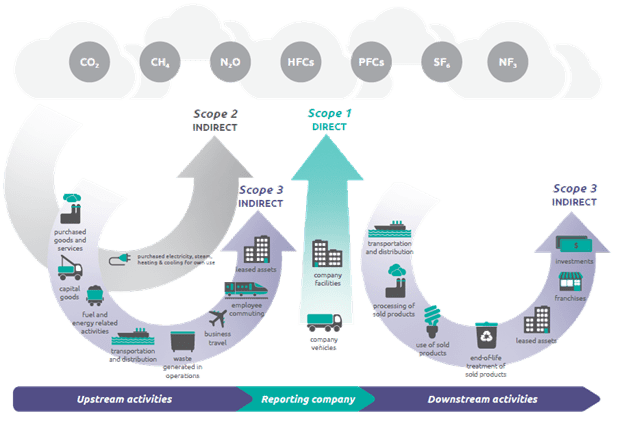
Source: GHG Protocol
WHY THE SUPPLY CHAIN CARBON INVENTORY MATTERS NOW
In industrial B2B, purchased goods and services account for the highest proportion of Scope 3 emissions and due to the nature of the industrial B2B supply chain characterized by SMEs -out of which only 2% of them report their CO2 emissions and have a reduction target in place- in the initial years of Scope 3 estimations Buyers had to use data of relatively low quality due to limited availability.
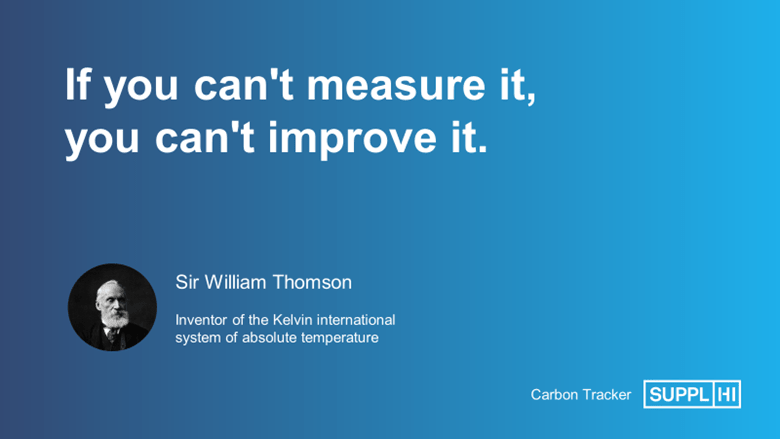
However, with the adoption of treaties, pledges, and new targets combined with an ever-increasing overall focus on the theme, Buyers are becoming more and more responsible for the CO2 emissions of their suppliers.
Indeed, on May 26th, 2021, the Hague District Court issued a ruling ordering Shell, to ensure that the aggregate annual volume of all CO2 emissions of the Shell Group, its suppliers, and customers is reduced by at least net 45% by the end of 2030, relative to 2019 levels. This is the first ruling in the Netherlands in which a non-State entity is ordered to reduce CO2 emissions. Such ruling can potentially pave the way for further climate change litigation against non-State emitters of CO2 in and outside of the Netherlands as well.
In this global scenario, it is now clear that Buyers need to boldly stimulate and carefully monitor suppliers and sub-suppliers to develop carbon inventories and to set challenging reduction targets.
BUYER’S CHALLENGES ON CARBON EMISSIONS IN INDUSTRIAL B2B
Due the presence of a fragmented, long, and complex Supply Chains in the industrial B2B, accounting of CO2 emissions is particularly difficult.
- CAPTURING THE REALITY: How do I collect trusted Primary data (including realistic reduction targets) on CO2 beyond the top 10% of Suppliers?
- CASCADING CARBON AWARENESS: How do I encourage a fast and solid adoption of CO2 metrics in a fragmented supply chain made of SMEs and several layers?
- TRACKING PROGRESS: How do I monitor and collaborate on CO2 reduction targets and Performance Improvement across the years with my Suppliers and Sub-Suppliers?
In industrial B2B, CO2 measurement and reduction is a Supply Chain-wide effort.
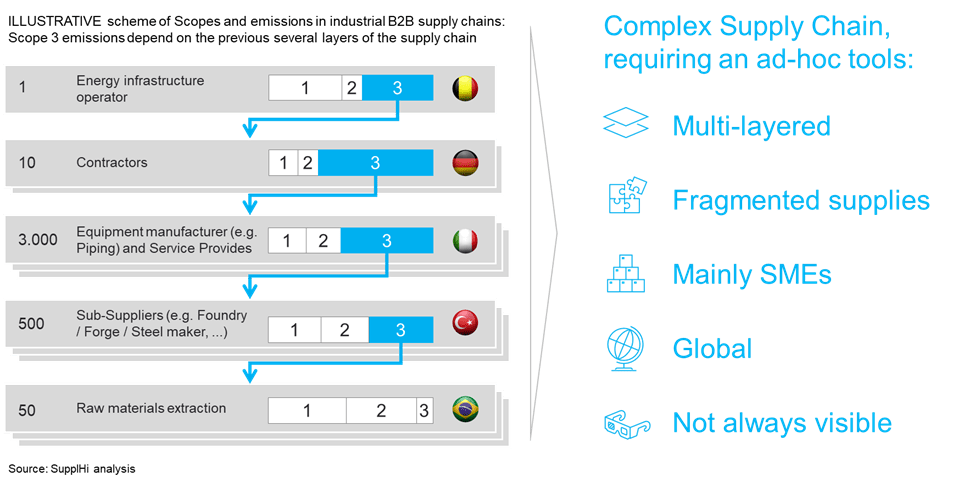
To tackle these challenges and achieve a true and effective carbon measurement and monitoring on large and fragmented global supply chains, Buyers need to quickly scale through a smart and collaborative digital solution for Supplier Engagement of Carbon emissions.
EVOLVE YOUR SCOPE 3 CARBON INVENTORY, NOW
Adopting a smart and – most important of all – a collaborative digital solution that is used by not only a single player but the industry itself, Buyers can finally improve the data quality of their Scope 3 carbon emission inventories, prioritizing supplies that have relatively low high emissions and relatively low data quality, reverting the initial situation in which they used data of relatively low quality due to limited availability.
A tool that allows Buyers to collect cradle-to-gate carbon inventory primary data through a “supplier-specific method” and – when possible – at product-level, not only does help overcoming inefficiencies caused by broad sector averages as these do not represent nuances of unique processes and products, especially for the fragmented supplier base in industrial B2B but also allows targeting reductions and demonstrating reduction effort results which otherwise would not be possible through secondary data.
The innovative and collaborative SupplHi SaaS which is specific for the industrial B2B (Energy, Shipbuilding, Construction, Manufacturing, …) on a global scale has recently introduced a free-of-charge “SupplHi Carbon Tracker” for calculation of Scope 1 and 2 of the Suppliers, further complementing its 360° Supplier Management solution, through a focus on industrial B2B Supply Chain CO2 estimation and monitoring.
Unlike for other existing market solutions, the registration on SupplHi free-of-charge for Vendors and is in constant contact with them that are digitally onboard also for Vendor Qualifications and Assessment Visits by independent 3rd parties (Lloyd’s Register, DNV, TÜV Austria, …).
UNIQUE BENEFITS OF SUPPLHI “CARBON TRACKER”
Modeled around a collaborative approach and being specific to industrial B2B SupplHi has a unique value-offering for the market at large, including both Buyers and Vendors.
- Industry-Specific Network Suppliers can collect the data once and use it for reporting with multiple Buyers. Moreover, Vendors are in turn also Buyers, activating the presence of Sub-Vendors on the same platform;
- Vendors already Onboard: an additional module of the existing SupplHi Vendor Management Platform, incorporating by design all data information management and cybersecurity requirements;
- Free-of-Charge for Vendors: enabling immediate adoption, without barriers for the already existing 60.000 Vendors on SupplHi from 110 geographies;
- Best of Breed: the SupplHi Carbon Tracker is built on the world’s most trusted carbon accounting frameworks and standards (GHG Protocol, SBT, …).
![]()
Through Carbon Tracker, the Vendor:
- obtains an automatic quantification of its CO2 emissions (Scope 1, 2 and 3)
- defines reduction targets (to 2025, 2030, …) based on the Science Based Targets (SBT)
defines initiatives to reach Targets (based on the Standard Databank of CO2 reduction initiatives managed by SupplHi)
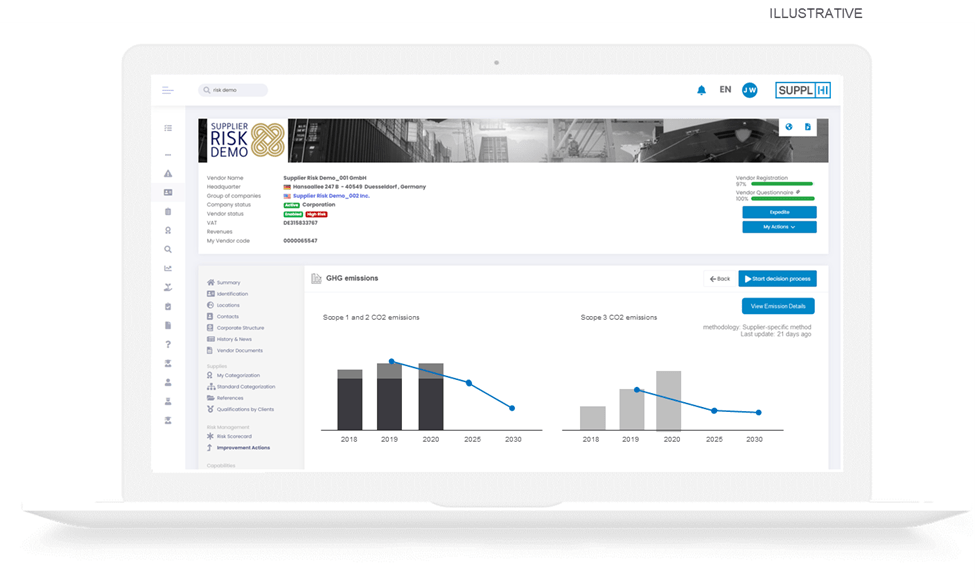
Through Carbon Tracker, the Buyer:
- access from the first day to Carbon emission data collected from Vendors that have already measured them;
- expedite the reporting of more Vendors through invitation campaigns digitally managed on the platform;
- monitor Vendor Carbon emission targets (e.g. for 2025, 2030, 2035, …);
- view the progress of improvement actions suggested to Vendors by the platform, Buyer organizations and initiatives adopted by them to achieve their carbon emission targets.
Furthermore, possibility of Vendor’s carbon footprint and target validation by TIC co. and specialized Consultants.
To know more about how you can calculate your and your multi-layered supply chain’s Carbon emissions through a reliable, precise, and compliant method based on the international standards, book a live demo session with SupplHi experts.

